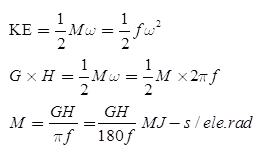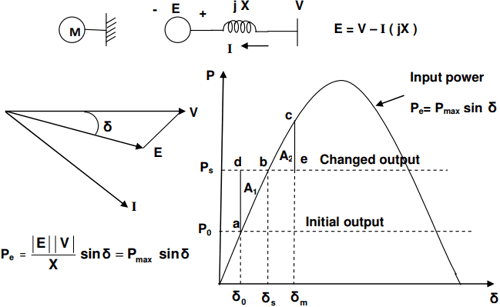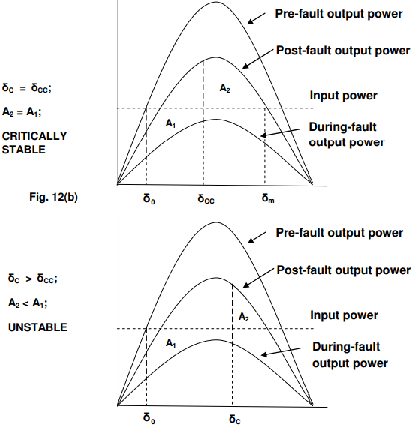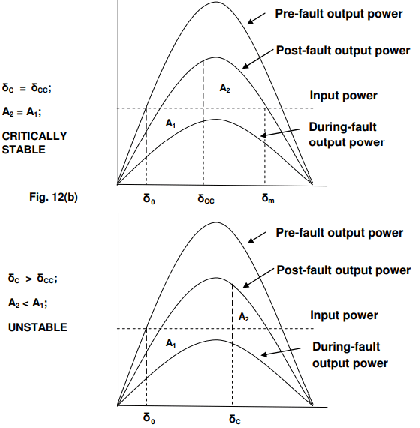System Stability Concepts | Power Systems - Electrical Engineering (EE) PDF Download
Power System Stability
A power system at a given operating state is stable if following a given disturbance or a set of disturbances. The system stays within specified bounds and the system reaches a new stable equilibrium state within a specified period of time.
The stability studies which evaluate the impact of disturbances on the behavior of synchronous machines of the power system are of two types: transient stability and steady state stability.
- The transient stability studies involve the determination of whether or not synchronism is maintained after the machine has been subjected to a severe disturbance. This may be a sudden application of large load, a loss of generation, a loss of large load, or a fault (short circuit) on the system. In most disturbances, oscillations are such magnitude that linearization is not permissible and nonlinear equations must be solved to determine the stability of the system.
- Steady-state stability is concerned with the system subjected to small disturbances wherein the stability analysis could be done using the linearized version of nonlinear equations. In this experiment, we are concerned with the transient stability of power systems.
In practice, load change may not be gradual. Further, there may be sudden disturbances due to
- Sudden change of load
- Switching operation
- Loss of generation
- Fault
Swing Equation

Where M = Iω = Angular momentum in J-s mechanical radian.
I = Moment of Inertia.
Pa = Iαω = Taω = Accelerating power
α = Angular acceleration
ω = Angular velocity
Ps = Shaft power
Pe = Electrical power
δ = Power angle or torque angle
Inertia Constant
Inertia constant 
Stored energy in megajoule = G × H

Inertia constant (H) on a Common Base

Where S = MVA rating
Key Points
- The equivalent inertia constant (Heq) of several identical machines working in parallel is the same as that of any one of the machines (Heq = H).
The equivalent inertia constant (Heq) of two machines on a common base swing coherently Heq = H1 + H2 - The equivalent inertia constant (Heq) of two synchronous machines which do not swing together is.

Power Output of the Generator
Consider the following figure, for the calculation of power flow

Complex power output of the generator
Where, E = | E | < δ = Voltage behind direct axis synchronous reachtance of generator
| V | = Terminal voltage of generator
Xd = Direct axis synchronous reactance of synchronous machine
Active power output of generator
Reactive power output of generator,

where,
Pt = Synchronizing power coefficient
Power Flow
For lossless line R = 0 and the transmitted power.
R + jX = z<θ
For lossless line, R = 0 and the transmitted power.
Where Vs = Sending end voltage
VR = Receiving end voltage
X = Reactance of the line
δ = Load angle
Key Points
- For maximum power transferring δ = 90o

- For power to be maximum

Equal Area Criterion
- The accelerating power in swing equation will have sine term. Therefore the swing equation is a non-linear differential equation and obtaining its solution is not simple.
- For two machine system and one machine connected to infinite m bus bar, it is possible to say whether a system has transient stability or not, without solving the swing equation.
- Such criteria which decide the stability makes use of the equal area in power angle diagram and hence it is known as Equal Area Criterion.
- Thus the principle by which stability under transient conditions is determined without solving the swing equation, but makes use of areas in power angle diagram, is called the Equal Area Criterion.

- In a two-machine system, under the usual assumptions of constant input, and constant voltage behind transient reactance, the angle between the machines either increases indefinitely or else, after all, disturbances have occurred, oscillates with constant amplitude.
- In other words, the two machines either fall out of step on the first swing or never. Under these conditions, the observation that the machines come to rest with respect to each other may be taken as proof that the system is stable.
- There is a simple graphical method of determining whether the machines come to rest with respect to each other.
- This method is known as the equal area criterion of stability.

- When the fault occurs at t=0, the electrical power output is suddenly zero while pm is unaltered.
- The difference in power must be accounted for by a rate of change of stored kinetic energy in the rotor masses.
- This is accomplished only by an increase in speed which results from the constant accelerating power pm.
- After reaching δ2, δ(t) will oscillate until losses and the load damp oscillations and δ(t) = δ0
- If δ2 > δ3 the generator loses stability because of pe < pm and the generator continues to accelerate.
Sudden load increase on Synchronous motor
Let us consider a synchronous motor connected to an infinite bus bar.

The following changes occur when the load is increased suddenly.
Point a Initial condition; Input = output = Po; ω = ωs; δ= δo
Due to sudden loading, output = Ps; output > Input;
ω decreases from ωs; δ increases from δo.

- Between a-b Output > Input
Deceleration; ω decreases; δ increases.
Point b Output = Input; ω=ωmin which is less than ωs; δ = δs.
Since ω is less than ωs, continues to increase. - Between b-c Input > output
Rotating masses start gaining energy;
Acceleration; ω starts increasing from minimum value but still less than ωs; continues to increase. - Point c; Input > Output
ω= ωs; δ= δm; There is acceleration; ω is going to increase from ωs; hence δ is going to decrease from δm.

- Between b-a Output > input
Deceleration; ω starts decreasing from ωmax ;
but still greater than ωs; δ continues to decrease. - Point-a; ω= ωs; δ= δ0; Output > Input; The cycle repeats.
Because of damping present in the system, subsequent oscillations become smaller and smaller and finally b will be the steady-state operating point.
Interpretation of equal area


Thus for stability, area δ0 a b c δm = area δ0 a d e δm
Subtracting area δ0 a b c δm from both sides of the above equation, we get A2=A1. Thus for stability,
Below we are showing three different cases:
The one shown in case a is STABLE. Case b indicates CRITICALLY STABLE while case c falls under UNSTABLE.

Application of Equal Area Criterion
Opening of one of the parallel lines
- When a generator is supplying power to an infinite bus over two parallel transmission lines, the opening of one of the lines will result in an increase in the equivalent reactance and hence decrease in the maximum power transferred.
- Because of this, depending upon the initial operating power, the generator may lose synchronism even though the load could be supplied over the remaining line under steady state condition.

Short circuits occurring in the system
- Short circuit occurring in the system often causes loss of stability even though the fault may be removed by isolating it from the rest of the system in a relatively short time.
- A three-phase fault at one end of a double circuit line is shown in the figure below which can be reduced as shown in next figure.

- It is to be noted that all the current from the generator flows through the fault and this current Ig lags the generator voltage by 90º.
- Thus the real power output of the generator is zero.
- Normally the input power to the generator remains unaltered.
- Therefore, if the fault is sustained, the load angle will increase indefinitely because all the input power will be used for acceleration, resulting in unstable condition.
- When the three-phase fault occurring at one end of a double circuit line is disconnected by opening the circuit breakers at both ends of the faulted line, power is again transmitted.
- If the fault is cleared before the rotor angle reaches a particular value, the system will remain stable.

- Stable, critically stable and unstable conditions of such systems are shown in figure below



- Expression for critical clearing angle δCC



- Thus Critical Clearing Angle is given by


Here the angles are in radian.
- Further, since Pm1sinδ0 = Ps & δm = π- δs, angles δ0 and δm are given by

|
30 videos|101 docs|45 tests
|
FAQs on System Stability Concepts - Power Systems - Electrical Engineering (EE)
| 1. What is power system stability? |  |
| 2. What are the main causes of power system instability? |  |
| 3. How is power system stability analyzed and assessed? |  |
| 4. What are the consequences of power system instability? |  |
| 5. How can power system stability be improved? |  |
















